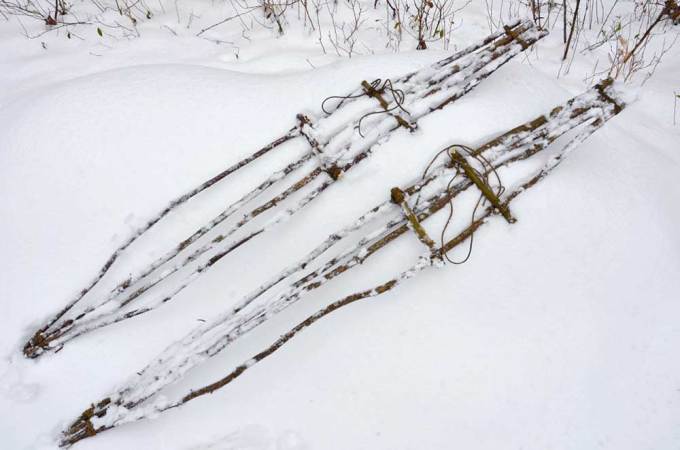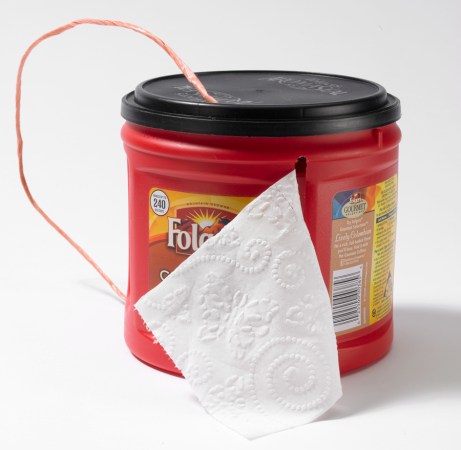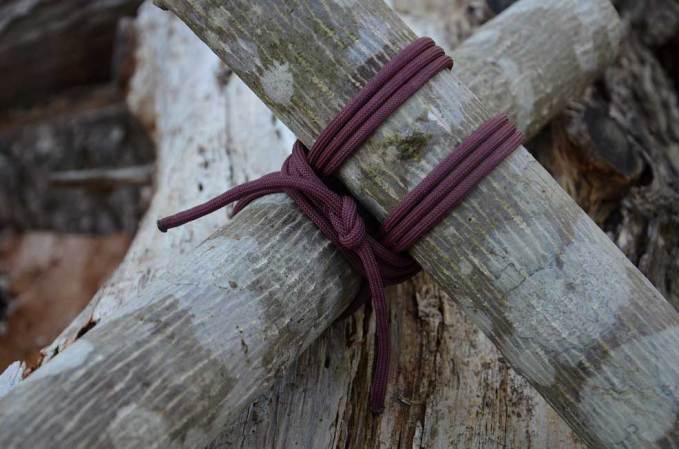

When wood dries, it shrinks, and when it shrinks, it can split. The unfortunate reality is that if you work with wood, you’ll eventually have to deal with cracks. Small amounts of cracking can be ignored and add to the charm of the piece—these can often be filled in with wood putty. Bigger ones, though, particularly those at the edge of the wood, can be ugly and compromise the integrity of your project.
One common method for repairing larger cracks is to simply cut them out of your piece and glue the wood back together. This makes the repair all but invisible. Another method, insetting something called a bow tie into your furniture, can turn a split into an aesthetic accent, and highlight the natural beauty of the wood.
Warning: DIY projects can be dangerous, even for the most experienced makers. Before proceeding with this or any other project on our site, ensure you have all necessary safety gear and know how to use it properly. At minimum, that may include safety glasses, a face mask, and/or ear protection. If you’re using power tools, you must know how to use them safely and correctly. If you do not, or are otherwise uncomfortable with anything described here, don’t attempt this project.
The cut-and-glue method
Stats
- Time: less than 1 hour (not including drying time)
- Material cost: $5 to $10
- Difficulty: Easy
Tools
- A table saw (or circular saw)
- Clamps
Materials
Instructions
This is the fastest and most straightforward way to repair thin cracks in wood. All you have to do is cut directly into and along the split with a table saw or circular saw, and then continue the cut all the way to the other side of the piece. Take more than one pass if the break is wider than your blade. Once the crack is gone, glue the seam back together using clamps to apply even pressure, and your furniture should look as good as new.
[Related: How to tune up your table saw]
However, there are a few drawbacks. First, if the crack is particularly wide, you’ll have to cut out a significant amount of material. This can reduce the width of, say, a tabletop, making it too small to fit atop its legs. A quarter of an inch can make a big difference. So this may not be an option for larger repairs.
Cutting out a section of wood can also ruin the grain pattern. If your furniture is made from a single slab or has a carefully designed grain alignment, removing an eighth or quarter of an inch can noticeably interrupt that aesthetic.
And finally, simply cutting out the crack does nothing to prevent future splitting.
Bow ties for the win

If you’re dealing with a particularly large crack, or you like a rustic look, consider repairing it with a bow tie. These are pieces wood cut in the shape of, well, a bow tie, that are set into the damaged wood perpendicular to a crack. Because they’re narrow in the middle and wide at the ends, they act as wedges to hold the wood in place and keep it from splitting further. While not the simplest woodworking project, they’re doable for anyone with patience and the ability to take careful measurements.
Stats
- Time: 1 to 2 hours (not including drying time)
- Material Cost: $10 to $50
- Difficulty: Moderate
Tools
- Band saw (or hand saw)
- Chisel (or sandpaper)
- Marking knife
- Palm router (or power drill)
- Orbital sander
- Rubber mallet
- Block plane
Materials
Instructions
1. Measure how large to make your bow ties. There are two elements that determine bow tie size: function and aesthetics. Each tie should be at least a third as thick as the piece of wood you’re repairing, and needs to extend lengthwise beyond the area you’re repairing. Look for microfractures alongside the primary crack and cut your bow tie to extend a half-inch or so past that.
Aesthetics are much harder to decide on. You’ll have to decide what kind of effect you want your bow tie to have. Even if the crack is small, a similarly small bow tie might look silly if you’re repairing a large coffee table. If the crack is long, you might want to use multiple bow ties of different sizes. One way to test the aesthetics is to cut out sample ties from pieces of paper. Lay these on your furniture to try out different looks. When you find one that works, use that paper as a template.
I typically create bow ties using an approximately 8-degree angle, for the simple reason that’s the angle of the dovetail jig I use as a cutting guide. But as long as the center of the bow tie is narrow and the ends are wide, the angle doesn’t matter too much. In fact, as long the center is narrow and the ends are wide, you can theoretically use any shape you want. I have dreams of someday repairing cracks in wood with a treble clef shape.
- Pro tip: If you don’t like the look of bow ties, you can install them on the bottom of your piece so you can’t see them.
2. Cut out the bow ties. The fastest and easiest way to cut a bow tie is with a band saw, but you can use any kind of saw you’re comfortable with. I typically secure my bow tie wood in a vice and cut with a Japanese pull saw. This allows me to use my dovetail jig to create uniform angles, and I don’t entirely trust myself when cutting small pieces on my band saw. Always work within your own comfort level around power tools, even if it takes a bit longer.
While cutting, make sure that the grain of the bow tie’s wood is parallel to its long side, not across its width. This will create a stronger wedge.
Once you’ve cut your bow ties, chisel off or sand down any imperfections so all the sides and edges are smooth. Burrs, overhangs, and cracks will make it hard to fit into your inlay hole later.
3. Trace your bow tie onto the cracked wood. This is the most important step to get right. I use double-sided tape to secure the bow tie in place with the narrow center on the main crack. You can also use CA (cyanoacrylate) glue and painter’s tape, hot glue, or even clamps. Whatever method you choose, don’t let the bow tie move while you’re tracing. Otherwise you could make the hole too big, which will weaken the inlay and—worse—look bad.
[Related: Get your scratched wooden cutting board looking bright and new]
If you have a sharp marking knife, use it to trace. If you don’t have one, I recommend picking one up. These invaluable tools create super-accurate cut lines, and provide a grove for your chisels to rest in when you hog out the inlay wood later. Alternatively, use a very, very sharp pencil.
4. Hog out most of the wood for the inlay. With your hole marked, remove all of the interior wood to a depth just less than the thickness of your bow tie. The best tool for this is a palm router with a straight bit. Set the bit depth and route out the hole. When routing, stay about a sixteenth of an inch inside of your line.
If you don’t have a palm router, use a power drill with a ⅜-inch or larger bit, depending on the size of your hole. Put a piece of tape around the bit as a depth gauge, and drill as many holes as you can inside your bow tie outline, again not actually touching the marks. Then come back with a chisel to remove the remaining wood and flatten the bottom of your hole.
You can also just use a chisel and mallet to remove the wood. This is time-consuming and labor-intensive, but it will get the job done.
5. Chisel the inlay hole to close to its final size. With the majority of your inlay hole dug out, cut to the line. Use a sharp chisel and a mallet for this. I typically use a half- or three-quarter-inch chisel, but use what you have, provided that it fits in the hole.
If you used a marking knife to trace your bow tie in Step 3, set the tip of the chisel into the groove, making sure it’s as close to straight up and down as you can get it. Then either hammer or push the chisel through the wood. Move the chisel over a bit and repeat, until you have cut to the line all the way around.
If you used a pencil to trace, line the tip of the chisel up on the pencil line as best you can and start cutting, being careful not to let your chisel slip or twist off of the line.
6. Test-fit the bow tie, then chisel and sand it as needed. If you were extremely precise with your tracing and cutting, your bow tie should fit tight inside the hole. However, chances are that you’ll need to adjust. Mark where it feels like the bow tie is getting hung up in the hole, and then either chisel the hole wider or sand the bow tie down, depending on which one seems to be uneven.
When test-fitting, don’t try to force the bow tie into the hole, or you may not be able to get it out (ask me how I know). It should be a tight fit but not get snagged in any one particular area. Also, don’t take too much off at a time—as with most woodworking, it’s better to take off too little than too much.
7. Glue the bow tie in place. When the bow tie fits in its hole, slather glue onto the bottom and sides of both. Then press the bow tie home, using a rubber mallet.
8. Plane and sand the bow tie. Using a block plane, shave the bow tie nearly flush, and then finish with an orbital sander. Try to sand while the glue is still wet, as the sawdust will mix with the glue, turning it the same color as the bow tie wood. This can hide the tiny gaps and imprecisions between the bow tie and the tabletop.
If you don’t have a block plane, or the bow tie is only barely above the tabletop, you can just sand, though it will take a bit longer.
9. (Optional) Fill the crack with epoxy. If you want a solid block of wood again, fill the crack with epoxy. However, this isn’t strictly necessary—some people like the look of an open split.
Typically, the epoxy pouring process goes like this: tape off the bottom and edge of the crack, mix your epoxy based on the manufacturer’s instructions, and pour it in, using a heat gun or small torch to pop the bubbles that rise to the surface. You may have to let the epoxy dry and then re-pour depending on the size of the crack. As always, follow the manufacturer’s recommendations for your specific product.
Once everything is dry, you’re done, and you can sit back and enjoy the new look of your bow tie furniture.














